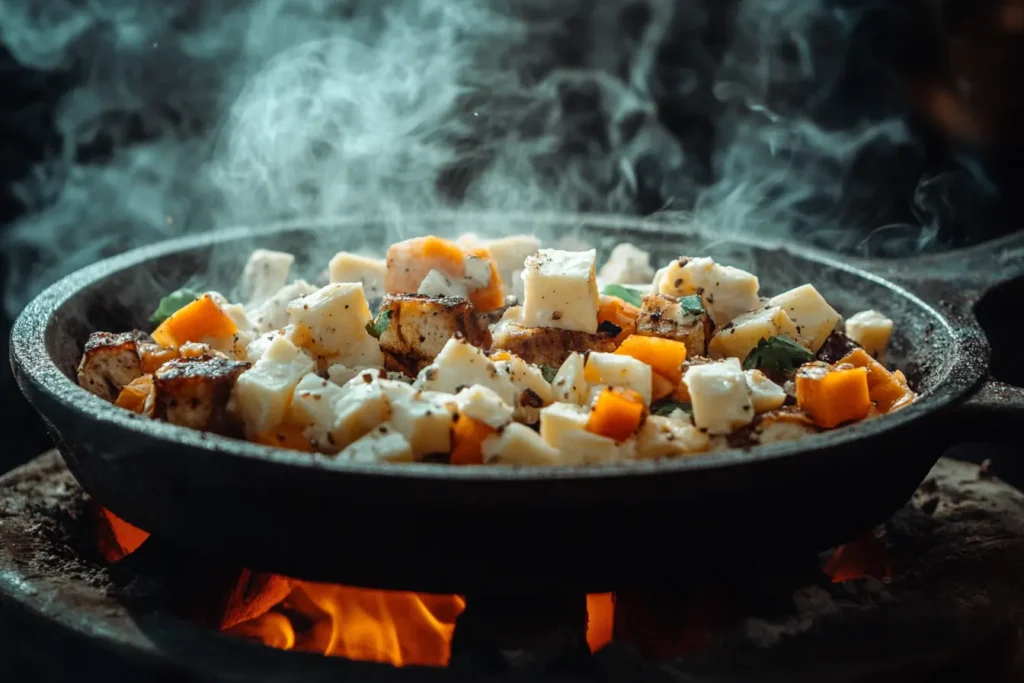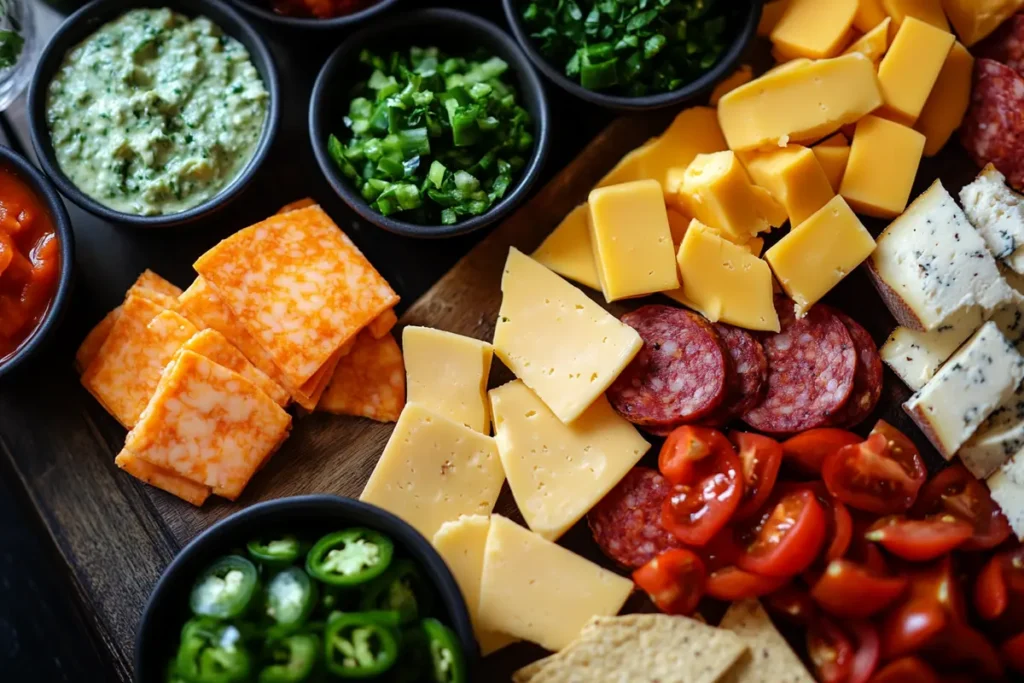Introduction
Smoked queso is a culinary delight that blends the creamy goodness of cheese with the irresistible aroma of wood smoke. Whether you’re hosting a barbecue, a game-day gathering, or simply craving a smoky snack, this dish is guaranteed to impress. However, here’s the kicker: the type of wood you choose can make or break your smoked queso. In fact, from mild to bold flavors, the right wood complements the ingredients, thus enhancing the queso’s flavor profile without overpowering it.
In this article, we’ll explore what wood is best for smoked queso and break down the science of wood selection, pairing techniques, and flavor profiles. By the end, you’ll have all the knowledge you need to craft a smoky masterpiece that’s sure to steal the show.
Introduction to Smoked Queso
Smoked queso is a delicious twist on the classic melted cheese dip. However, slow-cooked over wood smoke, this variation packs a rich, savory punch that elevates its flavor to new heights. With ingredients like creamy cheeses, diced tomatoes, spicy peppers, and even meats, smoked queso transforms into a multi-dimensional dish that tantalizes the taste buds. In fact, the smoky aroma enhances every bite, making it a must-have for parties and outdoor gatherings.
This isn’t just about melting cheese—it’s about infusing a medley of flavors that create a dip no one can resist. For example, imagine Velveeta paired with chorizo and jalapeños, all kissed by a subtle wisp of applewood smoke. Tempting, right? Thus, smoked queso brings a unique and irresistible charm to any occasion.
Why Smoking Enhances Queso Flavor
When you smoke queso, you’re not just cooking; you’re crafting. The wood smoke interacts with the fats and proteins in the cheese, creating complex flavors you can’t achieve any other way. Think about it: the gentle heat melts the cheese to a silky consistency, while the smoke infuses everything with a depth that lingers on your palate.
The choice of wood directly impacts this process. Sweet woods like cherry add a fruity tang, while bold options like mesquite provide an earthy, robust character. Smoking enhances queso because it marries creamy textures with smoky undertones, delivering a depth of flavor that plain queso simply can’t achieve.
The Role of Wood in Smoking Queso
Here’s where things get exciting: the wood isn’t just fuel—it’s flavor. Indeed, the type of wood you choose determines whether your queso is subtly smoky, sweet, or boldly robust. For instance, mild woods like alder offer a gentle touch that lets the cheese shine. In addition, fruity woods like apple add a sweet, tangy flavor. On the other hand, bold options like hickory create a strong smoky presence perfect for meaty add-ins.
By understanding the role of wood in smoked queso, you’re already halfway to crafting a standout dip. However, the key is balance—matching the wood’s intensity to the ingredients’ flavors ensures every bite is harmonious and utterly delicious.licious.
Importance of Wood Selection for Smoked Queso
The Science of Smoke and Flavor
The secret to great smoked queso lies in the smoke itself. Wood smoke contains aromatic compounds like syringol and guaiacol, which give food its smoky flavor. When you choose a specific wood for smoking, you decide the intensity and type of flavor that will blend with your queso. For a creamy dish like queso, the smoke needs to complement—not overpower—the cheese and other ingredients.
For instance, sweet woods like apple or cherry create a light, fruity aroma, perfect for mild queso recipes. In contrast, robust woods like mesquite add a bold earthiness that pairs beautifully with spicy meats. Understanding these nuances helps answer the question, What wood is best for smoked queso?
How Different Woods Impact Flavor Profiles

Each type of wood has unique characteristics that make it suitable for different recipes. For example, mild woods like alder and maple provide subtle smoke that enhances without dominating. Therefore, these woods work well with cheeses like Monterey Jack, allowing their mild flavors to shine.
In addition, sweet woods such as apple and cherry introduce fruity tones, pairing wonderfully with tomatoes and peppers. On the other hand, bold woods like hickory and mesquite offer intense, smoky flavors, making them perfect for recipes with bacon or chorizo.
Choosing the right wood lets you tailor the flavor to match your recipe’s ingredients. Thus, for a balanced smoked queso, try combining mild and bold woods to create layers of flavor that complement each other beautifully.
Avoiding Unpleasant Tastes with Proper Wood Selection
Not all woods are created equal when it comes to smoking food. For instance, softwoods like pine or cedar produce bitter, resinous smoke that can ruin the flavor. Therefore, it’s essential to always stick to hardwoods that are food-safe and enhance the dish. By doing so, you ensure your queso tastes smoky and delicious without unpleasant undertones.
Types of Woods for Smoking Queso
Mild Woods for Subtle Flavors
For a gentler, lighter smoky flavor, mild woods are your best bet.
- Alder: Known for its slightly sweet and clean smoke, alder pairs well with creamy cheeses like Velveeta.
- Maple: Maple’s mild caramel-like sweetness complements ingredients such as green chiles and onions.
These woods allow the natural flavors of queso to shine, making them ideal for milder recipes.
Sweet Woods for Balanced Notes
If you’re looking for a hint of sweetness, sweet woods like apple and cherry are perfect choices.
- Apple: Light and fruity, applewood enhances cheddar and tomatoes in smoked queso recipes.
- Cherry: Slightly tangier than applewood, cherry pairs excellently with pepper jack cheese and jalapeños.
These options are great for balancing rich and spicy flavors.
Bold Woods for Robust Tastes
For those who love a smoky punch, bold woods like hickory and mesquite bring a hearty flavor.
- Hickory: A classic choice, hickory adds a bacon-like smokiness that’s unbeatable with chorizo or ground beef.
- Mesquite: This wood is intensely earthy and best used sparingly for bold, Southwestern-inspired queso.
When using bold woods, balance is key—pair them with strong ingredients to avoid overpowering the dish.
Blended Wood Combinations
To achieve complexity in your smoked queso, try blending woods:
- Apple + Hickory: This combination is sweet and robust, perfect for balancing vegetables and meats.
- Cherry + Mesquite: The tang of cherry mellows out mesquite’s intensity, creating a bold yet balanced dip.
Experimenting with blends can help you find what wood is best for smoked queso based on your personal taste.
Pairing Wood Types with Smoked Queso Ingredients
Matching Woods to Cheeses

Cheese is the heart of smoked queso, so pairing it with the right wood ensures a delicious balance.
- Cheddar: The sharpness of cheddar pairs beautifully with sweet woods like apple. The subtle sweetness balances the cheese’s strong flavor, creating a harmonious blend.
- Monterey Jack: A mild cheese like Monterey Jack benefits from softer woods such as alder or maple. These woods let its creamy texture and subtle taste shine.
- Pepper Jack: With its spicy kick, pepper jack works well with cherrywood. The wood’s fruity undertones complement the heat, adding depth.
For processed cheeses like Velveeta, opt for lighter woods like alder, which enhance the dish without overwhelming its smooth texture.
Best Woods for Meats in Queso
Many smoked queso recipes include hearty meats that add richness and flavor. Pairing the right wood with these proteins makes all the difference.
- Chorizo: The bold, spicy flavor of chorizo is enhanced by robust woods like hickory. It deepens the smokiness, complementing the sausage’s seasoning.
- Ground Beef: This versatile meat pairs well with a blend of cherry and applewood. The fruity tones offset the richness, creating a balanced smoky flavor.
- Bacon: Bacon naturally pairs with hickory due to its strong, smoky taste. For a slightly sweeter twist, blend hickory with applewood.
Choosing the right wood for your meats can elevate the question What wood is best for smoked queso? to new heights.
Perfect Woods for Vegetable Additions
Vegetables like tomatoes, peppers, and onions add fresh, vibrant flavors to smoked queso. The wood you choose can enhance these ingredients.
- Tomatoes: Applewood’s light and fruity smoke enhances tomatoes’ natural sweetness.
- Peppers: For bell peppers, maple adds a mild, sweet smokiness, while jalapeños benefit from cherrywood’s tang.
- Onions: Maple or cherry brings out the sweetness in onions, enriching the overall flavor of the dip.
By carefully matching woods with your queso’s ingredients, you can create a dip that’s perfectly balanced and utterly irresistible.
Techniques for Smoking Queso Perfectly
Preparing the Smoker and Ingredients
Before diving in, make sure your smoker and ingredients are ready. Preheat the smoker to 225°F, and choose your wood chips or chunks based on your desired flavor profile. Use a cast-iron skillet or an aluminum pan to hold your queso mixture, as these withstand the low, slow heat of smoking.
Combine your cheese, meats, and vegetables in the pan, ensuring even distribution. Add a splash of milk or cream to help the cheese melt smoothly during smoking.
Optimal Smoking Duration and Temperature
For the best results, smoke queso at a steady 225°F for 1-2 hours. Stir the mixture every 30 minutes to ensure even smoking and prevent the cheese from sticking to the pan. The low temperature allows the smoke to penetrate the queso without burning or drying it out.
Keep an eye on the texture and flavor throughout the process. The smoky aroma should complement—not overpower—the ingredients.
Tips for Controlling Smoke Intensity
Managing smoke intensity is crucial for creating balanced smoked queso. Too much smoke can result in a bitter aftertaste, while too little leaves the flavor flat. Here are some tips:
- Use mild woods for longer smoking sessions to avoid over-smoking.
- Soak wood chips in water for 30 minutes before adding them to the smoker for a steadier release of smoke.
- If using a mix of woods, start with the mild option and gradually add the bolder wood to control the intensity.
With these techniques, you’ll master the art of smoking queso and confidently answer the question What wood is best for smoked queso?
For more delicious recipes, check out our Creamy Tortellini Soup Recipe, which pairs wonderfully with smoked queso at any gathering.
Customizing Your Smoked Queso Flavor Profile
Experimenting with Unique Add-Ins
One of the best parts of smoked queso is its versatility. You can easily customize the flavor by adding unique ingredients that complement your choice of wood.
- Black Beans: Pair black beans with cherrywood or applewood for a smoky-sweet combination. The fruity smoke enhances the earthy richness of the beans.
- Corn: Sweet corn works wonderfully with maple wood, adding a subtle caramel-like flavor to the dip.
- Spices: Amplify the smokiness with bold spices like cumin, smoked paprika, or chili powder. These spices pair well with robust woods like mesquite or hickory.
Experimenting with add-ins can help you refine the question, What wood is best for smoked queso?, based on your taste preferences.
Blending Woods for Advanced Flavoring
If you’re looking to take your smoked queso to the next level, blending different woods can create complex and layered flavors.
- Apple + Hickory: This blend combines the fruity sweetness of applewood with the bold, smoky depth of hickory. It’s perfect for queso with both vegetables and meats.
- Cherry + Mesquite: The tangy notes of cherry soften mesquite’s strong, earthy flavor, creating a bold yet balanced dip.
Blending woods allows you to customize the smoky profile of your queso, ensuring it’s a hit at every gathering.
FAQs on Smoking Queso
What is the best wood for smoky but mild queso?
For a queso that’s rich but not overwhelming, choose mild woods like alder or maple. These woods provide a gentle, sweet smokiness that enhances the cheese without overpowering it. They’re ideal for recipes featuring milder cheeses like Monterey Jack or mozzarella.
Can I use pellet smokers for smoked queso?
Absolutely! Pellet smokers are a great option for smoked queso. They offer precise temperature control and a wide variety of flavored pellets, such as apple, cherry, and hickory. This flexibility makes it easy to experiment and find what wood is best for smoked queso in your recipe.
What wood should I avoid when smoking queso?
Avoid softwoods like pine, cedar, or eucalyptus. These woods produce resinous smoke that’s bitter and potentially toxic. Always stick to hardwoods that are food-safe, such as apple, cherry, or hickory.
How long should I smoke queso for the best results?
For a creamy, flavorful queso, smoke it for 1-2 hours at a steady temperature of 225°F. This gives the cheese enough time to absorb the smoky flavor while remaining smooth and melty. Stirring every 30 minutes ensures even smoking and prevents burning.
Conclusion
Summarizing the Art of Choosing Woods for Smoked Queso
Creating the perfect smoked queso is as much about the choice of wood as it is about the ingredients. From mild and sweet options like alder and applewood to bold choices like hickory and mesquite, your wood selection shapes the dip’s flavor profile. The right wood enhances the dish’s creamy texture, rich cheeses, and savory add-ins, making every bite unforgettable.
Understanding what wood is best for smoked queso involves experimenting with different woods and blending flavors to match your taste preferences. Whether you prefer a subtle hint of smoke or a bold, robust punch, the perfect wood can transform your queso into a crowd-pleasing masterpiece.
Encouraging Creativity and Experimentation
Smoked queso isn’t a one-size-fits-all recipe—it’s an opportunity to get creative. Don’t hesitate to try new wood combinations, unique add-ins, or even regional twists to make the dish your own. Add sweet woods for a fruity touch or bold woods for a stronger smoky profile. Play around with spices and meats to create layers of flavor that suit your style.
Most importantly, have fun! Cooking should be an enjoyable experience, and the process of smoking queso lets you explore your culinary creativity. With the right wood and a little imagination, you’ll impress every guest at the table.
Additional Tips and FAQs
How to Pair Smoked Queso with Other Dishes
Smoked queso pairs beautifully with a variety of sides and snacks. Serve it with tortilla chips, fresh veggies, or crusty bread for dipping. For a heartier spread, pair it with grilled meats or smoked chicken. The smoky flavor complements barbecued dishes perfectly.
Want more inspiration? Try serving smoked queso alongside Crock Pot Chicken Tenders for a flavorful and satisfying combo.
Final Thoughts on What Wood is Best for Smoked Queso
Choosing the right wood isn’t just about flavor; it’s about balance. By matching your wood to your ingredients and desired intensity, you can elevate a simple dip into something extraordinary. Whether it’s the subtle sweetness of applewood or the bold intensity of mesquite, the wood you choose plays a pivotal role in answering the question, What wood is best for smoked queso?
Now it’s your turn—fire up that smoker, pick your wood, and create a queso that’s rich, smoky, and absolutely unforgettable!
Nutritional Content of Smoked Queso (Per 100g)
Nutritional Breakdown
Smoked queso is a rich and indulgent dip, but understanding its nutritional profile helps you enjoy it while staying mindful of your dietary needs. Below is a breakdown of the nutritional content for a typical smoked queso recipe:
| Nutrient | Amount (Per 100g) |
|---|---|
| Calories | 320 kcal |
| Protein | 12 g |
| Total Fat | 26 g |
| Saturated Fat | 15 g |
| Cholesterol | 60 mg |
| Carbohydrates | 8 g |
| Dietary Fiber | 1 g |
| Sugars | 4 g |
| Sodium | 740 mg |
| Calcium | 250 mg |
How to Balance Nutrition
To make smoked queso slightly lighter:
- Use low-fat cheese to reduce fat content.
- Add more vegetables like tomatoes or peppers for fiber and lower calories.
- Control sodium by using reduced-salt cheese or seasonings.
Enjoy smoked queso in moderation, and it can be part of a balanced diet while still being irresistibly delicious!

